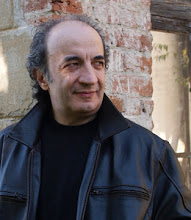
My dear Japanese friends
Tomorrow morning I'll meet Esagono at Turin's airport, Caselle and we'll go to Rome and from Rome to Tokyo.
I'm re-experiencing the pleasure and excitement of comin' in Japan.
First of all I want to give you a picture of the scene you'll find.
I will play tunes from "Pianovagando" my solo piano album that's comin’ out very soon, next month, as well as pieces from arti & mestieri's repertoire, a couple of Beatles & Stones' classics and some totally improvised pieces.
Basically As "Pianovagando" with 57 pieces focus on me as a Composer and interpreter with just some improvisations, the live concert is quite different, starting from the tunes and improvising a lot.
My live concept of improvisations is so free as well as with the character of becoming structured as the tunes goes on, "linked by surprise".
I mean I like to improvise real themes, chord sequences, rhythm, riffs, melodies & more melodies, creating moods, dynamics and so on so much "on the spot", on that moment with obviously an high degree that unpredictability is the only certainty!
With these premises, obviously, the audience, the place, the piano, the unique atmosphere of those nights, of those moments will switch on passion, emotion, colours, adventure games and ... more!
I will seat in front of a wonderful Yamaha Grand Piano
On Tuesday and I'll start with "Alba mediterranea" a piece I wrote for arti & mestieri and that I composed, inspired by a dawn in Sardinia, years ago.
After I'll play "Gianfranco" dedicated to arti & mestieri's singer that died on '86 a very romantic melancholic tune.
Next tune. "Over the Ocean" is a modal Hard boppish tunes I wrote the first time I flight over the ocean.
After there will be a special rendition of "Eleanor Rigby", followed by a total improvisation piece called "STB 1".
Next there will be "Ode", inspired by the great poem by A, Shaughnessy.
After it there will be another full improvisation called "STB 3".
The end of the show will be "Birth"
The second night I will open with "Montmartre" dedicated to that fabulous moment in time in early '20's in Paris.
It will be followed by "Sin Fronteras".. that's passion extracted from my Spanish heart... no frontiers in art.
"Back Home" that come after, was composed after being on military services for the first 40 days, touching guns and ... no pianos for 40 days and getting this tune as soon as I reached my home and my great friend, my first vertical piano.
After that a Stones' Classic, "Paint It black", using black and white keys to re-paint it with my colours.
Then we have a full improvisation called "STB 2", followed by a piece dedicated to my little village, where I live, "S. Sebastiano" with echoes of old Italian popular music, so rich in melody and emotion as everyone knows everywhere, ...it's Italian DNA.
After that another full improvisation "STB 4" and at the end,.. "birth" as ... the world end is meaningless in the music world, so "birth" seemed the right way ... to end!
... Id' like to say more, but at this time I want the music speaks by itself letting the Piano translate my moods in emotional sounds for you.
my friends,
see you there,
till then,
stay happy,
BEPPE
*******************************
日本の友達へ、
明日の朝、トリノ空港でESAGONOのみんなに会って、その後、ローマに行き東京へ向かうよ。
日本にもうすぐ行けると思うと、また、喜びと興奮してくるよ!
それでは、まず、ライブで観られるシーンを教えよう。
初めに僕が弾く曲は、来月発売されるソロ・アルバム「Pianovagando」からだよ。そしてart&mestieriの曲、 Beatles & Stonesの曲、全く即興した曲もプレイするよ。
基本的に、57ピースある「Pianovagando」は、作曲として演出として、いくつか即興も加えながら焦点を置いている。ライブでは、即興が多いところが全く違うところだね。
僕のライブ即興の概念は、とても自由であり、曲が進むにつれて、構造化されて行く特徴を持っている。
つまり、僕は、真のリズム、和音系列、リズム、リフ、メロディー、ムード作り、ダイナミックさなどを即興するのが好きなんだよ。その瞬間、その場での予測できないのが、唯一の確実性なんだ。
これらを前提に、明らかに、観衆や、場所、ピアノ、ユニークな雰囲気の夜、その瞬間は、情熱に、感情、色、アドベンチャーゲームなどにスイッチを付けるでしょう!
僕は、素晴らしいヤマハのグランドピアノの前に座るんだ。
木曜日、ari&mestieriのために書いた曲「Alba Mediterranea」から始めるつもりだよ。
その後、「Glanfranco」を弾く。1986年に亡くなったartiのシンガーに捧げるとてもロマンチックで憂鬱的な曲さ。
次は、「Over the Ocean」。海の上を飛行機で飛んだ時、初めて書いた曲。
その後、「Eleanor Rigby」の特別な演奏をして、それから「STB1」と呼ぶ全くの即興曲を演奏する。
次に、素晴らしい詩人 A. Shaughnessy に感銘させられた「Ode」を演奏するよ。
次に、「STB3」と呼ぶ完全即興を演奏する予定。
最後の曲は、「Birth」。
2日目の最初は、20年代初期のパリの素晴らしい時に献呈する「Montmartre」で始めるよ。
その後、「Sin Fronteras」。これは、僕のスペインの心の情熱だ。芸術には、国境はない。
そして、「Back Home」。これは、兵役初めの40日間に書いたもの。40日間もピアノから離れて、鉄砲に触れていた。家に、友達に、そして、僕のピアノに戻ったらすぐ、この曲が出来たんだ。
その後に、ストーンズのクラシック、「Paint It Black」を演奏する予定。黒と白の鍵盤を、僕の色でペイントするんだ。
次に、「STB2」即興曲。そして、僕の住むサン・セバスティアーノの村に贈る曲なんだけど、古いイタリアのポピュラーミュージックで、メロディー豊かでどこの誰もが知っている曲だよ。
その後、完全な即興曲「STB4」を演奏して、「Birth」で演奏をくくる。
いかにも、世界の終わりは、音楽界の終わりとは無意味であるように。
だから、「Birth」は、終わりにはちょうどいい曲なんだ。
もっと言いたいことありけど、僕の感情的なサウンドのムードを自分のピアノで語ることにしよう。
それでは、日本で会おう。
それまで、ハッピーでね。
Beppe


















